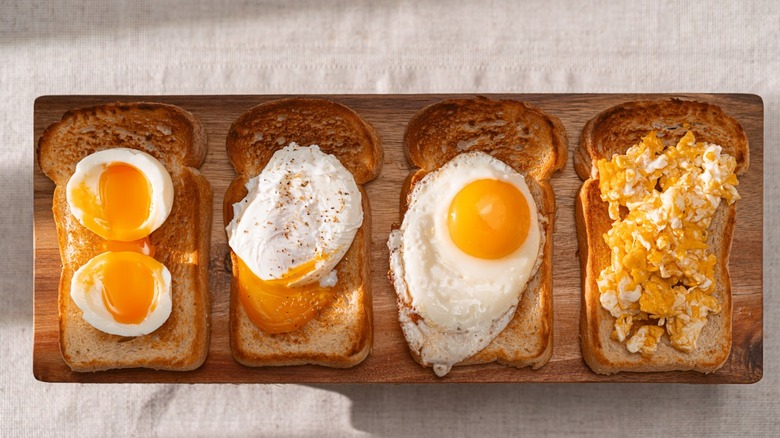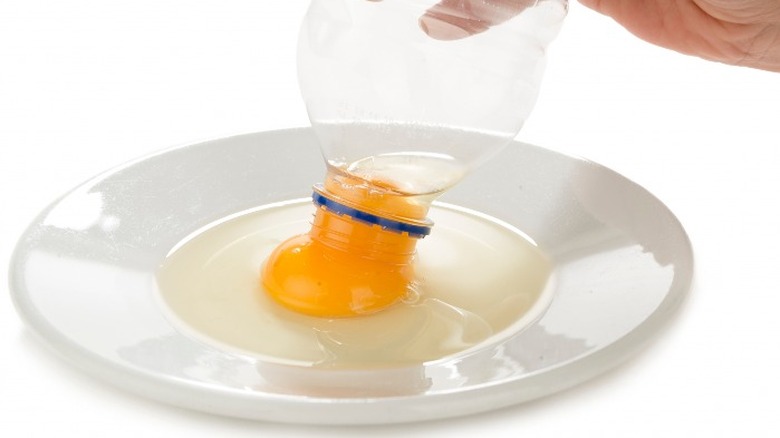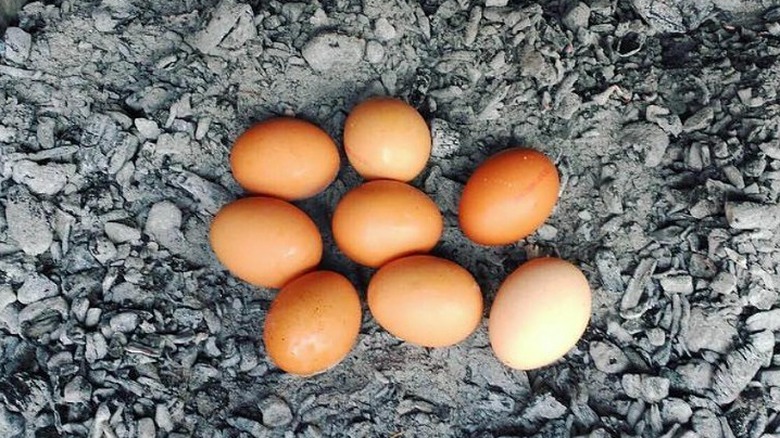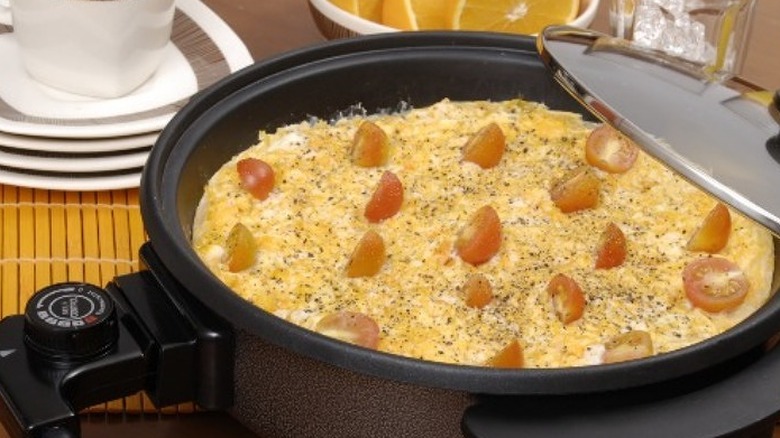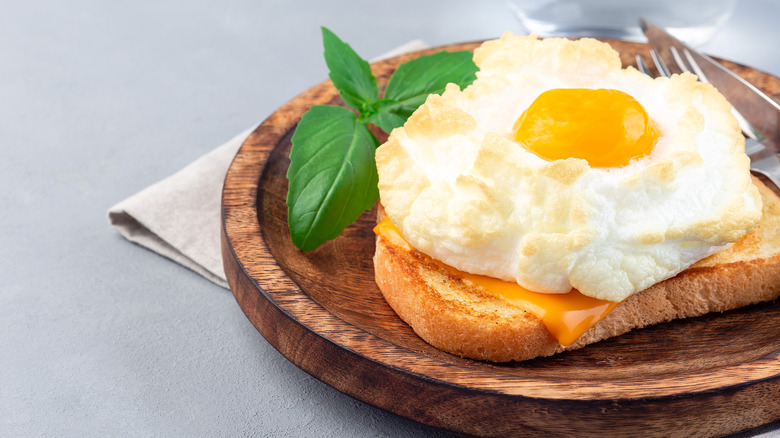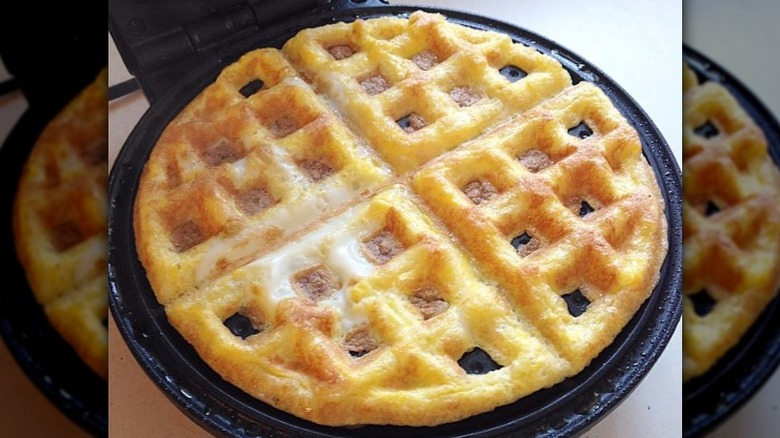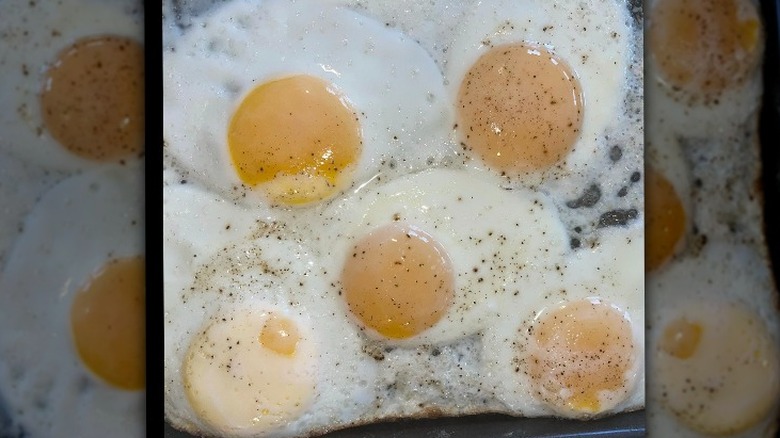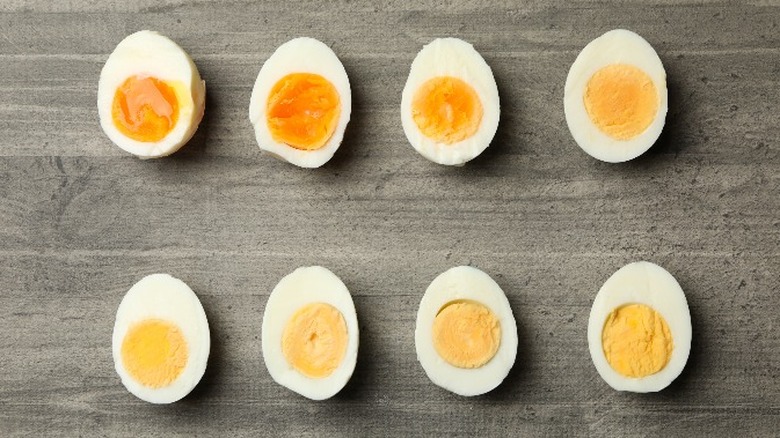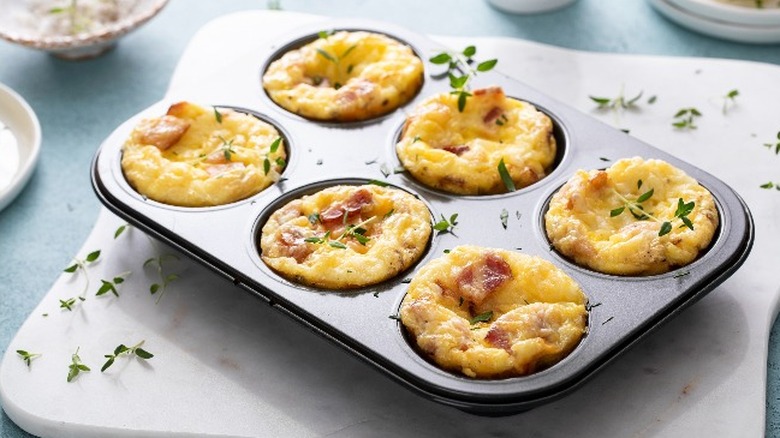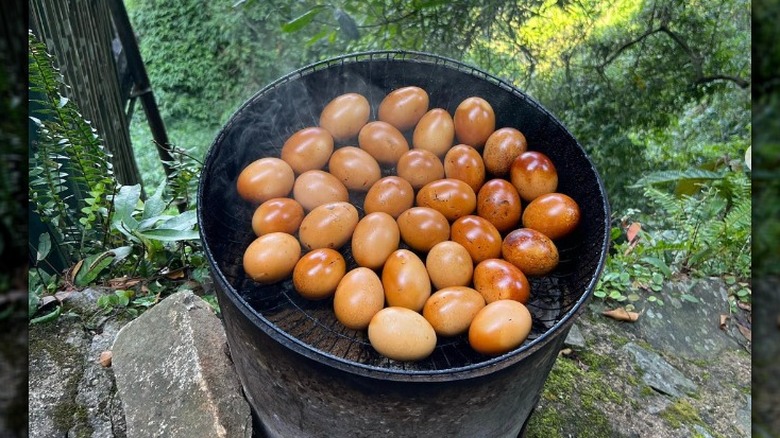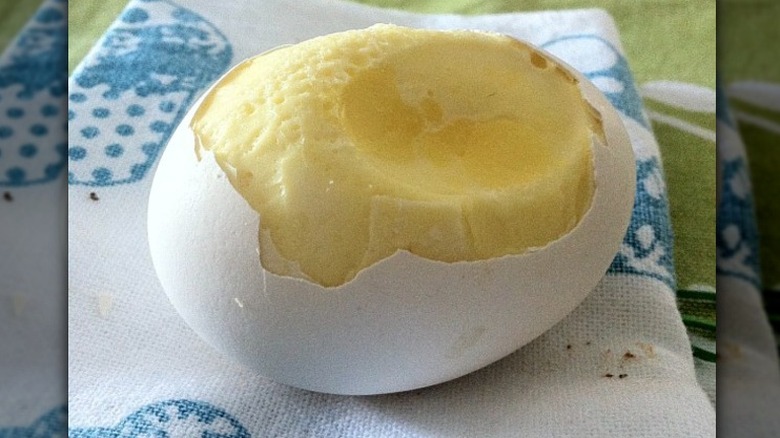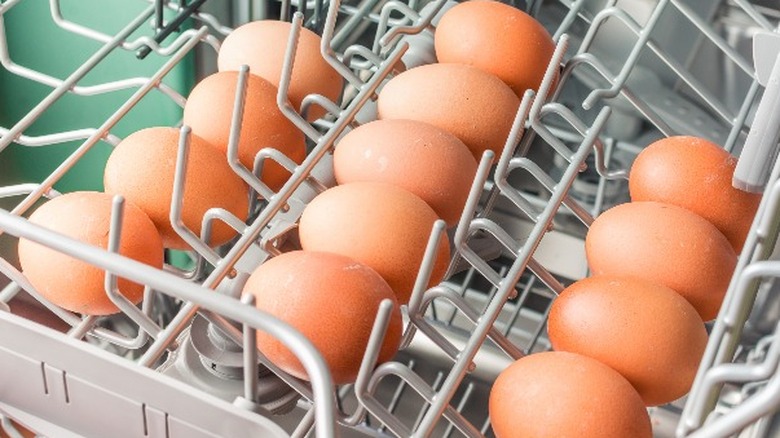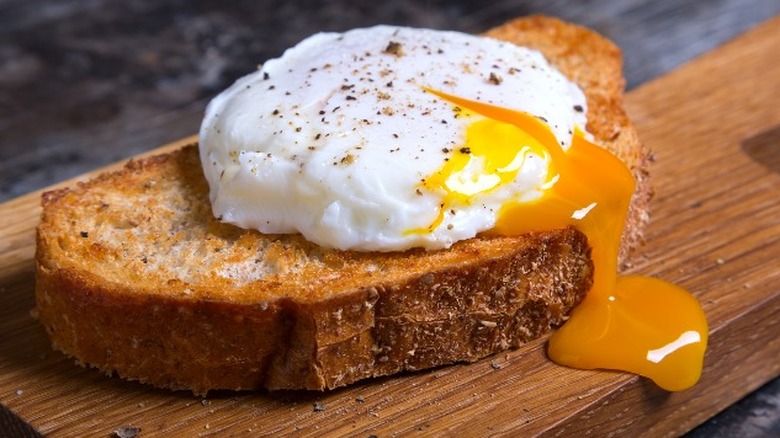12 Unconventional Methods For Cooking Eggs
North Americans eat a lot of eggs, most of us averaging 288.1 in 2022 (via Statista). But with all the different ways to prepare them, why wouldn't we crave them? Full of high-quality protein, Egg Farmers of Canada explains that this food contains the nine essential amino acids that the human body requires yet cannot produce, making them highly nutritious. Not just that, they're really tasty and can be used in so many ways that it's easy to see why we get through as many as we do. However, even an old favorite can sometimes use a little upgrade. If you've been looking for something out of the ordinary to try with your eggs, we've got you covered.
Affordable and generally easy to find, eggs are one of the most versatile ingredients in our kitchens. That might also mean we start to take them for granted because they're no longer exciting. That doesn't have to be the case, though. With this little collection of hacks and unconventional cooking methods, you might begin looking at your eggs with fresh eyes and start having fun again. And if that isn't enough to tempt you, why not combine some of those tricks with some of the best egg recipes of 2021? We guarantee you'll find something that makes your stomach rumble and your fingers itch to get cracking.
Use a water bottle to separate eggs
If separating eggs strikes fear in your heart, this tip is for you. Using the shell to separate the whites from the yolks can be pretty tricky — you have that rough edge to contend with, just waiting to pierce the yolk and ruin everything. If you have a plastic water bottle on hand, then you've got a terrific tool for sucking up the yolks, like a little protein-loving vacuum.
Crack your egg onto a plate, being careful not to break the yolk. The whole reason this works is because of the structural integrity of the yolk versus the utterly uncontainable runniness of the white. If you require more than one egg, we suggest cracking and separating them one at a time. This helps avoid breaking yolks unnecessarily and making the entire exercise futile. Take your empty (and clean) bottle, remove the cap and squeeze out some air — not all the air, just compress it enough to create a little suction. Place the opening over the yolk and release the bottle, letting the vacuum created to suck up the yolk. Squeeze it out into a bowl and move on to the next one. Steve Spangler, a man who loves science and eggs, has a great video on his site if you're looking for step-by-step visual instruction.
Try roasted eggs
Roasted eggs might be familiar to some of you, especially if you observe Passover. The traditional seder plate contains a roasted egg called Beitzah, symbolizing the rebirth of spring, the ultimate cycle of life, and is a reminder of sacrificial offerings (via My Jewish Learning). Roasted eggs are also a popular Korean street food and as an appetizer in Mauritius, as well as in many other cultures. If you're looking for something different and delicious, you might want to try roasting them. A roasted egg takes a little more prep than other eggs on this list — you need to know that a raw egg will explode if you try popping it over a flame.
Mr. Breakfast recommends boiling the egg first and then giving it a quick roast over your gas element. An electric element should also work, but you might not have as much control. He also says that it's possible to roast them in the oven without pre-boiling. Just make sure to gently prick both ends to let the steam escape. He does point out that roasting one egg in the oven takes quite a bit more time and electricity than most other methods, so it might not be the way to go, but at least you can be secure in the knowledge that it's possible.
Cook a big batch in a slow cooker
Slow cookers are a savior in our collective kitchens, and for a good reason. It's a hands-off device that mostly looks after itself, except for the cleanup. If you're looking for a simple yet effective way to serve up a large volume of eggs all at once, you've found your answer. While a pile of cold, hard-boiled eggs might be okay for some occasions, there are times when nothing beats a warm plate of perfectly fluffy, scrambled eggs. Using a slow cooker means that most of the preparation is done for you. Even better, those gorgeously creamy eggs will stay at the desired temperature until everyone is served.
One of our best tips for this method is to make certain that you use a good deal of butter to grease the inside of the crock before adding your eggs to avoid hours of soaking and scraping later. Trust us when we say that baked-on eggs are nearly impossible to remove. Don't be tempted to use cooking spray because it just doesn't have the power to prevent those eggs from latching on and never letting go. There's also such a thing as slow cooker liners, which alleviate the need for adding anything at all.
Make fluffy cloud eggs
An exquisite version of a sunny-side-up egg, the cloud egg was reintroduced to the world through a TikTok video showing an egg cooking while the white is continuously and vigorously whipped. The result is a soft yolk enveloped in an enormous froth, just barely golden on the edges. The video makes it seem like it was all cooked at once, but the whites were likely whipped and then cooked, and the cooked yolk was added later. This is the easiest way and is the most widely accepted method. Cloud eggs have been around for a while, but it wasn't until social media discovered them that these terrifically photogenic eggs saw a resurgence.
If you're wondering how the adorable edible tastes, it depends on any additions that you choose to add. Eggs whites aren't known for their savouriness so expect that a plain cloud egg won't taste like much at all, except yolk. While the trendiness might come from the cheerful appearance, Vogue asserts that the frothy egg whites make an excellent stand-in for an actual biscuit, perfect for those avoiding carbs or gluten. Add anything you like to your egg whites but be aware that the more you put in there, the less volume you'll see. For ultra-fluffy clouds, bake the whites unflavored, then garnish to your liking.
Make an omelet in a waffle iron
Scramble up a couple of eggs, add anything that tickles your fancy, and then pour it into a steaming hot waffle press. A lot less work than making a true omelet, and you don't have to worry about managing all that delicate flipping first thing in the morning, either. The beauty of a waffle iron is that it cooks both sides perfectly. You'll end up with something even better than an omelet because it also has golden brown, crispy edges — especially when you load it with cheese.
At its most basic, this delight is known as a chaffle (cheese and egg waffle). For the perfect chaffle, we recommend one egg to a quarter cup of cheese. And just like a regular waffle, the shape is perfect for piling on the toppings. You can also cook a fried egg with a runny yolk by just cracking an egg right onto the griddle and leaving the lid open.
We have another tip for you when making eggs in your waffle iron. If you're not a big fan of aerosol "butter," you can simply melt some real butter and brush it all over your waffle pan before pouring in your egg mixture. But remember that you shouldn't use a spray if your waffle maker is non-stick; you'll end up wrecking the coating.
Cook a large quantity on a sheet pan
Another way to make a ton of eggs easily, this trick uses a sheet pan to make pretty quick work of multiple batches of eggs at once. It's not so great if you need all your fried eggs to have free-form, organic edges but absolute perfection for serving more than four people at a time. If you're not cool with straight-edged whites, we also have a tip to fry multiple eggs at once without having to slice them apart.
To make a big batch of sunny-side eggs, you only need a decent sheet pan and a handful of eggs, plus a little oil (or butter if you're in the mood for something extra tasty). A regular-sized pan will easily cook 12 eggs; if you only want six eggs, a half-sheet pan is the one to use. Six eggs on a large pan will spread too much, and the whites will burn before the yolks are set. Crack your eggs onto a well-greased pan and season with salt and pepper. At 350 F, a dozen eggs will take about 12 minutes, depending on how firm you like those yolks. We don't recommend this for making in advance and freezing — eggs are best frozen when the fatty yolks are mixed with the whites. Otherwise, things will get rubbery pretty quickly.
Use a coffee pot to boil eggs
While this trick might call to mind desperate situations, such as a long road trip with only a dozen eggs and a motel room coffee maker, this hack will make boiling your eggs much easier. Got a 12-cup coffee maker? You can have a literal pot full of eggs in minutes. At home, this is a terrific alternative if you're pulling together a big dinner and all the stovetop burners are occupied. On a road trip, this is the answer to hundreds of delicious egg salad-fueled miles. And if you're in a college dorm with no cooking options, you'll never be hungry again.
First, you're going to (gently) fill your coffee pot with eggs — raw and in the shell. Put in as many as will fit (about six) or as few as you need. Fill up the coffee maker reservoir with water, hit the button, and let the boiling water pour over the eggs. The burner will keep them cooking until they're ready. Five to six minutes will give you soft-boiled eggs, and 10 to 12 will provide hard-boiled. While waiting for your eggs to cook, find out how you've been making egg salad wrong, and then commit to using your newly created ingredient in all the best ways. Carefully pour them into a bowl of ice water and peel. Can we suggest some terrific Asian-inspired Scotch eggs?
Bake your eggs in a muffin tin
A muffin tin can serve eggs in many ways, making it indispensable, especially when you want to cook a lot at a time. Serve up a pile of scrambled egg bites by mixing eggs in your preferred method and pouring them into a pre-buttered muffin tin (or ungreased if it's non-stick). Depending on how big you want them, you can count on one to two eggs per cup. Bake for 18 to 20 minutes and serve. Add anything you like to make them into a mini-omelet, like bacon, chopped red peppers, green onions, cooked mushrooms, or just a pile of cheese. These can easily be frozen for pre-made egg and biscuit brekkies all week long.
A muffin tin is also a terrific way to cook them in the shells (like hard-boiled eggs, without boiling). Place an egg in each muffin spot and slide it into a preheated oven. We found that 30 minutes at 325 F worked for us, but if you're unsure about your oven's temperature, you can cook an egg or two first. Once you've got the timing right, you can tackle eggs for a crowd. Want to crush brunch? We can tell you how to poach eggs in a muffin tin so you can serve a dozen eggs benny at once.
Try grilling your eggs
If you're a seasoned camper or really love your grill, then you've likely already figured out how to grill eggs. A cast-iron pan of eggs takes on such an incredibly different flavor when cooked over a flame that you might not want to return to basic oven-cooked eggs. Hyperbole? Maybe. But freshly grilled eggs are good. Because they are cooked at a higher temperature, it contributes to something delicious called the Maillard reaction that gives them a little extra oomph.
Cooking them on a grill is about the same as on the stove, but times will vary. If you're a confident cook, then you shouldn't have a problem. Slide a cast-iron pan on the grill and scramble or fry to your heart's content. Even better? Slice a red pepper in half and cook the egg in that.
The next step up is grilling a whole egg in the shell, like hard-boiled but a lot less genteel. Pop a few whole eggs onto your grates (not over full flames, just gentle heat), close the lid and give it about 10 minutes for a jammy yolk. We'll call them cowboy eggs. Obviously, you can also boil up a pot of water and cook your eggs in the normal (but far less cool) way. If you're looking for a challenge, give Thai grilled eggs a shot — just be careful with that skewer.
Scramble them still in the shell
What happens when you're on the go and need breakfast but can't stomach another cold egg white? What if we told you that you could crack open a pre-scrambled cooked egg? It's true, and we'll tell you how to do it. There are a lot of products on the market that promise to pre-scramble eggs, but no one needs another one-trick-pony gadget.
To do it at home without a plastic gadget, all you need is one leg from a pair of tights, or a plastic bag, a long-sleeved t-shirt, and some elastic bands. The point is that you're going to be spinning your eggs around, using centrifugal force to break the yolk and incorporate it into the white. You can see if you've successfully made a golden egg by shining a flashlight through the shell in a dark room. You're looking for a dark red color instead of bright yellow — that's how you know it's time to boil that baby. Not only is this a great recipe for people who aren't into egg whites, but it's also a terrific science experiment for the kiddos. And food experiments are the best experiments! Once your eggs are all spun up, cook them as you would make hard-boiled eggs and reap the rewards of your scientific expertise.
Hard-boil eggs in the dishwasher
Along the lines of using your coffee pot, think of your dishwasher as a bigger, slightly more aggressive way to cook a lot of eggs at once. Like, a LOT of eggs. Line them up on the top rack and put them through a cycle, and that's about all it takes. Keep in mind that while this method is terrific for many eggs, it does take an entire wash cycle to perform the miracle, so don't count on having breakfast in minutes. The Sun UK suggests adding foods, like fish, veggies, or eggs, to your not-quite-full dishwasher while also doing dishes makes use of wasted water and energy. And you'll find that it works much like a sous vide cooker without the expense of taking up all that counter space.
Want something a little more specific information? If you're planning to run an actual wash cycle, you should probably put all those eggs into containers to avoid devilled eggs that taste like soap. You can toss them into plastic zip-top bags or pop them into mason jars or any other sealed vessel. For soft-boiled eggs, we suggest a one-hour cycle at 149 F. Hard-boiled eggs can be achieved by letting the eggs sit and continuing to cook once the load is done.
Sieve them for a better breakfast
A surprising tool for making better eggs is your metal sieve, which can be used in several ways. You'll find that cracking eggs into a sieve will help remove the excess liquid from the whites. The whites become more watery as an egg ages, and running them through a sieve will help eliminate that excess moisture. Simply crack the egg into a sieve and let the thinner liquid escape. Discard it and continue cooking your eggs as normal. According to Chef Kelly Scott, this hack works exceptionally well for making fluffier scrambled eggs and helps your poached eggs retain a tighter shape.
Another use for your sieve is to make hard-boiled egg crumbles that are a delicious addition to fresh veggies or salads. If you find yourself with an excess of hard-boiled eggs, say after Easter (or if you went overboard with the dishwasher hack), passing the yolks and whites through a sieve or even a box grater (as per The Press Democrat) is a terrific way to make a tasty, protein-packed garnish, or even the creamiest egg salad ever. Slice your eggs in half and remove the yolks before pressing through the sieve. It's an extra step, but we found it easier to manage this way.
